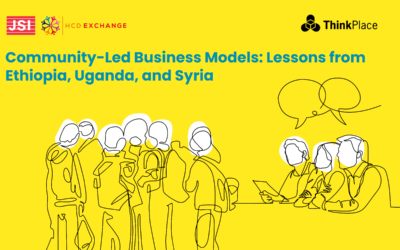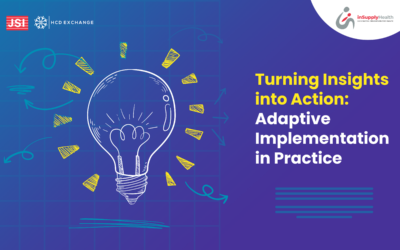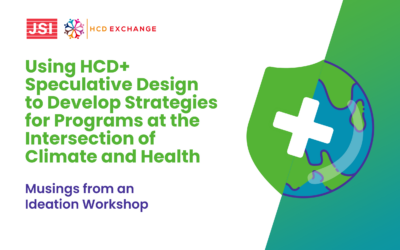Public health practitioners are increasingly leaning on inclusive and user-centered approaches such as human-centered design (HCD) – which offers a powerful framework for addressing public health challenges by placing the focus population at the center of the solution design process. The HCDExchange recognizes the incremental gains of the application of HCD in public health programs and wants to build on them.
This year, as part of our mission to nurture the next generation of local design talent, one of our objectives is to expand skill sets for public health practitioners to lead and implement meaningful HCD+Public Health programs. To this end, we hosted our first quarterly masterclass of the year in March, in collaboration with Circle Innovation. This masterclass was conceptualized to enable practitioners to learn from experienced professionals.
Case Study
To showcase how practitioners can apply HCD principles to a public health program, Circle Innovation introduced a case study focused on supporting leaders in their public health emergency preparedness and response, across 10 countries in Africa. In this project, Circle Innovation worked with stakeholders to design and implement a support initiative for public health emergency preparedness and response amidst the COVID-19 pandemic. They were guided by the following:
“How might we prepare public health leaders and other key stakeholders from African countries to manage public health emergencies?”
Design Research
For the public health emergency preparedness project, Circle Innovation conducted 30 remote design research sessions involving subject matter experts and target users of the end product to understand their needs, challenges, and learning preferences regarding public health emergency management and leadership. Through synthesizing this data, the design team was able to formulate an opportunity question aimed at designing an engaging leadership program. This shift in focus demonstrates the need for responsiveness in user feedback, to move from an initial assumption to a user-centered approach. For Circle Innovation, this shift led to a revised question that meaningfully centered on preparing public health leaders and stakeholders in African countries to effectively manage public health emergencies.
“While our research was conducted online, there are some things we needed to consider when conducting design research. It is important to think about the activities taking place. What is happening and what are the people doing?” – Nzisa Kioko, Senior Design & Innovation Strategist, Circle Innovation.
Ideation using the HCD Framework
Ideation is the process of coming up with ideas to explore options for solving a problem.
“The goal is not to come up with the perfect idea, but to come up with many different ideas, to collaborate, refine ideas, and come up with more ideas, and to be open and also think of crazy, unthinkable, and wild ideas!” Karina Fassbender, Founder & Managing Director, Circle Innovation.
Some ideation principles include:
- Defer judgment: all ideas are good! Keep away from judging your ideas or the ideas of others
- Encourage wild ideas by maintaining a safe space
- Build on the ideas of others – take other ideas as an inspiration, and actively think about how you can make them even better
- Stay focused on the topic
- One conversation at a time: listen to the ideas of others, and provide everyone with the opportunity to share their ideas
- Be visual: often it’s much easier to build a common understanding with sketches, images, photos, or anything visual as opposed to with words
- Go for quantity: just start writing down your ideas, and you’ll notice how this opens up a floodgate to get all your ideas out.
Prototyping
Prototyping is making your ideas tangible and testable. There are different methods of low-fidelity prototyping tools, such as sketches, paper prototyping, digital wireframing, role play, mockups, and multimedia presentations. Prototyping helps to test ideas, get valuable feedback, fail, and learn. Some of the ways prototyping is helpful are:
- To transform an idea into something that people can see and interact with
- To learn more about: (a) the problem to be solved (b) the people being designed for (c) the different elements of an idea
- To explore the three core elements of innovation: a) feasibility b) desirability c) viability
Testing
Circle Innovation conducted 45-60 minute testing interviews with seven research participants and one focus group discussion involving eight participants. The project team synthesized field findings to identify emerging patterns to derive key insights. Recommendations from the project’s pilot phase informed detailed design suggestions for the digitization and piloting of the public health emergency leadership program.
Here are some helpful tips when testing a prototype:
- Test, don’t sell
- Take notes
- Focus on what works, what does not work, what is missing, and what questions are coming up
- Talk and explain as little as possible
- Allow users to explore as you observe
- Ask questions on how the user sees/understands different things.
Moving from prototype testing to a final solution
How do we move from prototype testing to a final solution? Here are some tips to follow:
- Implement the solution on a small scale. Remember to collect feedback as you implement the solution
- Analyze the feedback: what elements of the solution work? What does not work? Then make changes
- Scale: Define scaling at an organizational level. What resources are needed? What are the metrics to collect feedback and learn as you implement?
Resources
-
- Watch the webinar recording
- Read through the session slidedeck
- Learn more about Circle Innovation



